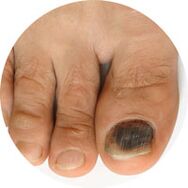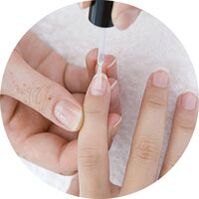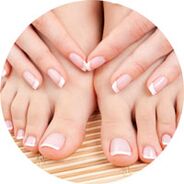Treatment of advanced forms of nail fungus takes more than a year. However, at an early stage, the disease can be dealt with more quickly. To do this, stains were created on the hands and feet from nail fungus.
Treatment of fungal nails with varnish: Indications and approach

Antifungal varnish is a tool that has just gained relevance in the fight against nail fungus in the early stages of infection, ie in cases where the plate is less than 50% damaged.
The tool is convenient and practical: unlike ointments, it does not dissolve and does not wash off after drying.
However, anti-fungal nail polish is indicated in only 2 cases:
- In the initial stage of the disease, when up to 30% of the plate is damaged and no more than 3 nails on one foot, on the arm. With wider and deeper foci, it is impossible to dispense antifungal tablets.
- For the prevention of onychomycosis. The coating reliably protects the nails from re-infection.
The drug can be prescribed for self-medication or as part of a complex treatment.
How does anti-fungal varnish work?
Nail fungus healing varnish on feet and hands has a liquid structure, is quickly absorbed and penetrates even into microcracks. The active substance begins to destroy the cell membrane, enzymes and spores of the pathogen. After hardening, the coating seals the plate, preventing oxygen from leaking out. Fungi left without a basis for vital activity stop multiplying and gradually die.
Mycologists also prescribe remedies for fungal prophylaxis, especially for people with excessive sweating and after prolonging acrylic. The obtained protective film prevents the penetration of moisture, fungi, infections into the nail. In addition, the alcohol, oils and plant extracts contained in the composition are disinfected and dried.
Effectiveness of treatment
Stains from nail fungus are effective only for the prevention and treatment of onychomycosis at an early stage. The drug forms a protective layer, quickly eliminates infection and prevents the emergence of new ones. Complete recovery occurs after 3 months of therapy, the first results are noticeable after 7-10 days.
Tests should be performed within a few weeks of completing the treatment. A laboratory test shows whether the infection is completely eliminated and whether a second course is needed.
Consult a mycologist or dermatologist before purchasing the product. The specialist will assess the degree and depth of the lesion, determine the stage and prescribe a suitable varnish for the foot or nail fungus.
How to use nail polish to treat nail fungus?
The frequency of use of a particular device is specified in the instructions. Usually in the first month the nails are varnished once in 2 days, in the second - twice a week, in the third - once a week. Therapy is carried out until a healthy plate grows.

Nail fungus varnish is applied to the feet and hands according to the following scheme:
- Pre-processing. Before treatment, feet or hands are steamed in a soda bath, washed thoroughly with soap and water. Then dry the surfaces and do a hygienic pedicure or manicure. The nails are cut, the top layer is polished with a nail clipper and cleaned with alcohol.
- Use of funds. Nail polish from the fungus is applied with a brush or spatula to dry plates. Actions are performed slowly and carefully so as not to damage the surrounding skin. In this case, the composition should cover the entire area of the nail.
- Further processing. The drug used should not be removed until the next procedure. However, after 10 minutes, after complete drying, decorative varnish can be applied on the healing varnish. Whether the manufacturer allows this is indicated in the instructions.
Contraindications
Fungal nail polish is not absorbed into the bloodstream and can not provoke intoxication. However, the drug is contraindicated in the following cases:
- Individual intolerance to components;
- Susceptibility to allergic reactions;
- Increased skin sensitivity;
- Children under 16 years of age;
- Pregnancy and lactation.
Spots are prescribed with caution in diabetes, diseases of the immune system.
Side effects
Toenail fungus and hand varnish rarely cause adverse reactions. In case of accidental contact with skin may be detected:
- Burns;
- Redness;
- Peeling;
- Swelling;
- Irritation;
- Itching.
If an allergic reaction has occurred, it is worth choosing an analogue of another active ingredient.
Attention! Nail fungus varnish reduces the effectiveness of combined contraceptives.
Prevention

After complete recovery the patient is often re-infected with the fungus. To prevent recurrence it is necessary to cover the nails with varnish for one month after the end of treatment.
Proper attention should be paid to hygiene: wash feet and hands daily, change socks, dry shoes. Towels and slippers should be individual.
Remember: Even the best nail fungus nail polish needs regular use. Without re-processing, the coating will gradually wash off. The result will be a favorable soil for the development of fungi.
In conclusion, it should be noted that if you experience symptoms of nail damage with a fungal infection and especially if it is accompanied by favorable factors, you need to seek qualified medical help.
Self-selecting experiments with therapy tools will not only help us in any way, but will also aggravate the existing situation. It is very easy to get a gift in the form of a mushroom on the nails, but it is quite difficult to cure. Therapy takes a long time and is often complex, so you should not start the disease by self-medication.































